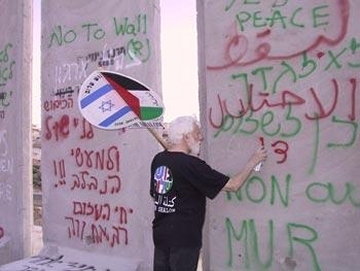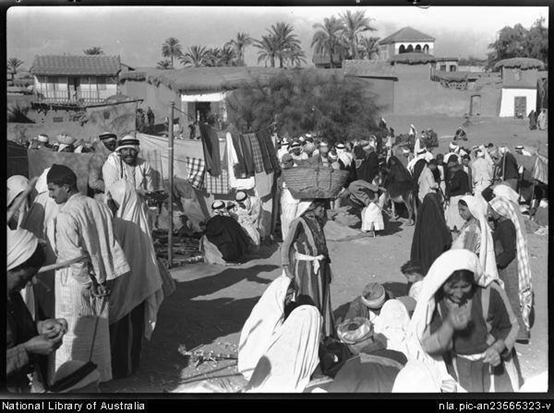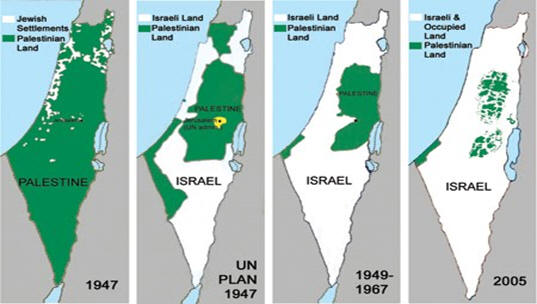www.aljazeerah.info
Opinion Editorials, February 2017
Archives
Mission & Name
Conflict Terminology
Editorials
Gaza Holocaust
Gulf War
Isdood
Islam
News
News Photos
Opinion Editorials
US Foreign Policy (Dr. El-Najjar's Articles)
www.aljazeerah.info
|
That's How the 1948 Arab-Israeli War Happened By Uri Avnery Al-Jazeerah, CCUN, February 13, 2017 Editor's Note: By Hassan El-Najjar Uri Avnery is a respected Israeli peace activist, who believes in the peaceful resolution of the Israeli-Palestinian conflict, through the two-state solution, at least now. I asked him to clarify his statement, in his previous article, about the Arab armies attacking Israel, thus starting the 1948 war. It is essential that those who believe in the Israeli-Palestinian peaceful coexistence to acknowledge the facts about what happened in 1948, as seen in both sides, not just to stick to one side of the story. His article today is a response to me and others. Apparently, he still did not want to revise his statement about that. Instead, he mentioned how Palestinians attacked the Israeli convoys coming to Jerusalem. In fact, Palestinians were defending their territory of the West Bank, which was allocated to them by the 1947 UN Partition Resolution, which made Jerusalem an international city, inside the Palestinian West Bank territory (See Partition map below). So, in their attempt to reach Jerusalem, Israelis attacked the Palestinian territory, which triggered the Palestinian resistance. Likewise, the Israeli claim, that the Arab armies attacked Israel in 1948, is also not true. They entered the territories allocated to the Arab State of Palestine, according to the 1947 UN Partition Resolution 181. The Egyptians entered Gaza, the Jordanian entered the
West Bank, and the Syrians, Lebanese, and Iraqis entered the
Galilee, all of which were territories of the Arab state according
to the resolution. |
 |
 |
|
A photo of the marketplace in Isdood (Ashdod), which was taken by an Australian soldier, who was stationed near this Palestinian village, during WW II. By the end of October 1948, almost all residents of Isdood left their village, which was under Israeli air and land attacks for several months. The remaining elderly were evicted to Gaza by the Israeli occupation forces. Isdood was the northernmost part of the Gaza Strip, which was allocated to the Arab State of Palestine by the UN Partition Resolution 181, but it was annexed to Israel at the end of the war. The Egyptian forces, which entered the Gaza Strip, stayed in Isdood and did not enter the Israeli area to the north. So, the Zionist claims that Arab armies invaded Israel in 1948 are false and baseless. They entered the territories allocated to the Arab State of Palestine. |
 |
|
|
The second map from left shows Palestine in green and Israel in white colors, according to the 1947 UN Partition resolution 181. Arab armies entered the Palestinian territories of Gaza (the south west green strip), the West Bank (eastern green area), and the Galilee (northern green area). They wanted to keep these Palestinian territories in Arab hands.
Jerusalem (the yellow area) was designated by the 1947 UN Partition Resolution 181 as an international city. But it was located in the middle of the Palestinian territory of the West Bank.
When the Israeli forces attempted to reach Jerusalem, they were in fact invading the Palestinian territory of the West Bank. This triggered the Palestinian resistance to the Israeli invasion. Thus, it was the Israelis who started the 1948 war to evict Palestinians from the Israeli and Palestinian territories as well as force the Arab armies out of the Palestinian territories, in order to annex most of them by the end of the war, as can be seen in the third map from the left.
This is the truth that needs to be acknowledged and told to the present and future generations on both sides. |
***
***
That's How the 1948 Arab-Israeli War Happened
By Uri Avnery
Al-Jazeerah,
CCUN, February 13, 2017
AFTER MY last article, in which I mentioned that the Arabs started the 1948 war after the partition resolution of the UN, I received several furious messages.
The writers, who (I suppose) were born after the events, accuse the Zionists of starting the war in order to expel the Arab population.
Since I took part in the events I was 24 years old at the time I feel that it is my duty to describe what really happened, as truthfully as possible. (I have written two books about it, one during the war and one immediately after.)
TO DESCRIBE the atmosphere in the country just before the war, let me recount one of the great moments of my life.
In the late summer, an annual folk dance festival took place in a natural amphitheater in the Carmel mountains. About 40 thousand young men and women were assembled, a very large number given that our total population was only about 635,000.
At the time, a commission of the United Nations (UNSCOP) was touring the country in order to find a solution to the Jewish-Arab conflict.
We were watching the dance groups among them one from a neighboring Arab village, who danced the Debka with such enthusiasm that they just couldn't stop - when the loudspeakers announced that members of the UN commission were visiting us.
Spontaneously, all the thousands of young men and women stood up and broke into the National Anthem with such vigor that the echo resounded from the mountains around us.
It was the last time that my generation was assembled. Within a year, thousands of those present were dead.
FOLLOWING THE recommendation of that commission, the General Assembly of the UN resolved on November 29, 1947, to partition Palestine between a Jewish and an Arab state, with Jerusalem as a separate unit under international rule.
Though the territory allotted to the Jewish state was small, the Jewish population realized the immense importance of statehood. It was just three years after the end of the Holocaust. The entire Arab world opposed the resolution. As they saw it, why should the Arab population of Palestine pay the price for the Holocaust committed by Europeans?
A few days after the resolution, a Jewish bus was shot at. That was the beginning of Phase 1 of the war.
To understand the events, one must consider the situation. The two populations on the country were closely intertwined. In Jerusalem, Haifa and Jaffa-Tel Aviv, Arab and Jewish quarters were situated close together.
Every Jewish village was surrounded by Arab ones. To exist, they needed use of the highroads, which were dominated by Arab villages. By now, shootings broke out all over the country. The British were still nominally in charge, but tried to get involved as little as possible.
The underground Jewish paramilitary organization, called Haganah ("Defense"), was responsible for keeping the roads open. Jewish traffic moved in convoys, defended by Haganah members, male and female. The females were needed, because they could hide the illegal weapons under their clothes.
The Arab side had no centralized command. Attacks were undertaken by villagers, many of whom had old rifles at home. Since some of these fellahin were quite primitive, atrocities happened. Our side retaliated the same way. As a result, this became a very bitter struggle.
One group of Haganah fighters, composed of university students, who rushed to the defense of a Jewish settlement bloc, was ambushed and killed to the last man. We saw photos of their severed heads paraded through the streets of Arab Jerusalem.
The inevitable strategy of the Jewish side was to remove the Arab villages along the highways. Jewish villages were told to stay put, whatever the price, though a very few of the most exposed ones were evacuated.
In February, 1948, the British evacuated a Tel Aviv area, and this became the nucleus of the Jewish state. The British left at the same time some compact Arab areas, too.
By the end of March, both sides had already suffered heavy casualties. Phase 2 began.
ON APRIL 1, my company was rushed to the improvised port of Tel Aviv to receive a large shipment of Soviet bloc arms. A year before, in a surprise move, the Soviet bloc in the UN had started to support the Zionist side. Stalin, as anti-Zionist as anybody could be, had probably decided that a Jewish state in Palestine was better than a British-US military base.
We spent a day removing the grease from the rifles, which had been produced by the Czechs for Hitler's army but were too late for World War II. That was the beginning of Phase 2 of the war.
The Jewish quarters of Jerusalem were cut off by the Arab villages on the road. Our operation, the first big one of the war, was to open the road.
A stretch of road, several kilometers long, passed though a narrow gorge, with steep hills on both sides. Bab-al-Wad (Arabic for "Gate of the Valley") was the terror of every soldier. If we were shot at from above, we would have to get out, climb these hills under fire and fight on top. Not a very pleasant prospect.
A huge convoy of 135 trucks had been assembled, and it was our job to get them to Jerusalem. My squad was allotted a truck carrying cheese, and we tried to arrange some cover between the crates. Luckily, we got through without being attacked. We entered Jerusalem on a Shabbat, masses of religious Jews left the synagogues and received us with immense joy, it resembled de Gaulle's entry into Paris. (By chance, a photographer took my picture there.)
We returned unscratched. Ours was the last convoy to get through the next one was attacked and had to turn around. Several costly battles to open the road, which was now blocked by an irregular Arab volunteer force from abroad, failed. We lost a hundred dead.
The road remained closed for decades. Our army found an alternative route which we called the Burma Road, after the British route from India to China in World War II.
BY THAT time it became clear that the regular armies of the surrounding Arab countries were about to enter the war. This changed the character of the fight entirely.
In preparation for the battle, the Israeli army "cleared" large stretches of land of their Arab inhabitants, so as not to leave Arab concentrations behind our lines. This could still be justified by tactical necessity.
On May 14, the last of the British left, and the next day the regular armies of five Arab states Egypt, Jordan, Syria, Iraq and Lebanon, with some help from Saudi Arabia entered the war (Correction: The Arab armies entered the territories of the Arab State of Palestine, not the Jewish State territory - Al-Jazeerah Editor).
They were regular troops, trained and equipped by their former British and French overlords, and had artillery and air power, which we still lacked.
On paper, the Arab side enjoyed a huge superiority in armaments, training and (I am not sure) numbers. But we had three advantages. First, we knew that we were fighting for our lives, quite literally, with our backs to the wall. We had a unified command, while the Arab armies competed with each other. And third: the Arabs had a profound contempt for us. Who has ever heard of Jews fighting? Also, in tactical terms, we had the advantage of "inner lines, being able to quickly move forces from one front to another.
The following weeks Phase 3 saw the most desperate fighting of the entire war, battles that resembled World War I. I saw battles in which almost all our fighters were killed or wounded, and a solitary last machine gun kept firing. There were hours when everything seemed lost.
But then, slowly, the fortunes of war turned. By the end of this round, we were alive and fighting, standing our ground.
Phase 4 still saw some pitched battles, even an attack with bayonets. But our side scented victory. It was then that the mass expulsion of the population of Arab towns and villages became obviously conscious (Israeli) government policy. At that point in time I was severely wounded and left the front.
When everybody on both sides was exhausted, the war ended with a set of armistices, which defined the recognized borders of Israel.
Within these borders, very few Arabs were left. But an almost forgotten fact is that not a single Jew was left in the areas conquered by the Arab side. Fortunately for us, these areas were few and small compared to the large areas conquered by our side. The term "ethnic cleansing" was not yet invented.
THESE ARE the facts. Everybody can build on them any interpretation and ideology they fancy.
But, please, no Trumpian "alternative facts".
***Share the link of this article with your facebook friends
|
|
|
|
||
|
||||||


